

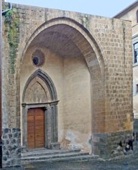
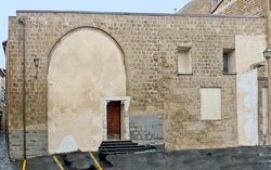
Facade in Via dei Mercanti Facade in Piazza Ranieri
The Carmelites, who were the last of the mendicant orders to arrive in Orvieto, built their church and adjacent convent in the open loggia known as the Loggia dei Mercanti. Two huge arches from this loggia, one in Via dei Mercanti and the other in Piazza Ranieri, can still be seen.
The work of adapting the existing structures to the needs of the friars was still incomplete in 1326, when they requested a subsidy from the Commune. They received a number of bequests after the Black death in 1348, and were able to restructure their convent around a cloister in 1360. The Provincial Chapter of their order was held here in 1362.
The Confraternita del Carmine, which was established in 1559 in an adjacent oratory, undertook the Baroque remodelling of the church. It also built a fountain (1580) next to the church, but this no longer survives. It was incorporated into the eponymous Roman confraternity in 1630.
The convent was suppressed in 1810. In 1820, the surgeon Giovanni Battista Pianzola left funds for an orphanage to be established in the convent, which became known as the “Orfanotrofio Pianzolano”. This establishments soon closed: part of the convent was then demolished and the rest was adapted for residential use.
However, the confraternity continued in operation into the 20th century. The church was then abandoned, and its roof collapsed. The church is now closed and has been adapted for secular use after its restoration in the 1990s. The complex now houses the Collettivo Teatro Animazione.
Exterior of the Church
[Gothic portal, small circular window above]
Interior of the Church
The remodelling of the church in ca. 1559 by the Confraternita del Carmine involved the construction of five stucco altars and the destruction of a number of earlier votive frescoes on the walls.
Annunciation (1394)
Pericle Perali (in his guide of 1919) mentions a fresco of the Annunciation to the right of the entrance of Santa Maria del Carmine, which was dated by inscription to 1394. He thought that it might be by Pietro di Puccio, but it has more recently been attributed to Andrea di Giovanni. [Is it still there ?] The fresco, which includes a donor portrait, probably formed part of a cycle of scenes from the early life of Christ.
Fresco Fragment [date?]
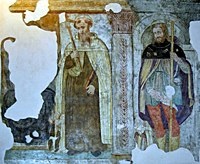
This interesting votive fresco, which survives on the left wall, depicts the Madonna and Child enthroned (almost completely lost) with a Carmelite saint and St Roch.
Marriage of the Virgin (16th century)
This fresco in a niche on in the right wall is attributed to Angelo Righi. Two scenes from the Life of the Virgin form a fictive predella.
Art from the Church
Madonna and Child (13th century)
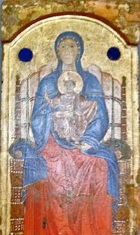
Frescoes (late 14th/early 15th century)
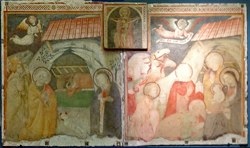
These detached frescoes from the Oratorio del Carmine are now in the Sala degli Affreschi of the Museo dell' Opera del Duomo. They were probably moved from the church during its remodelling in ca. 1559.
-
✴Three of them are attributed to Andrea di Giovanni and probably belonged to the cycle of scenes from the early life of Christ mentioned above. They depict:
-
•the nativity;
-
•the adoration of the Magi; and
-
•the presentation at the temple (fragmentary, not illustrated).
-
✴The fourth, which depicts the Trinity (also illustrated above), is by a different artist.
Coronation of the Virgin (1616)
Elena Marescotti commissioned this altarpiece by Giovanni Lanfranco for the altar that she had built in the church in 1615. It is now in Room V of the Museo dell' Opera del Duomo. It formed the basis of the design (1713) by Lodovico Mazzanti for the new mosaic in the tympanum of the facade of the Duomo: a fragment of this mosaic also survives in Room V of the Museo dell' Opera del Duomo.

